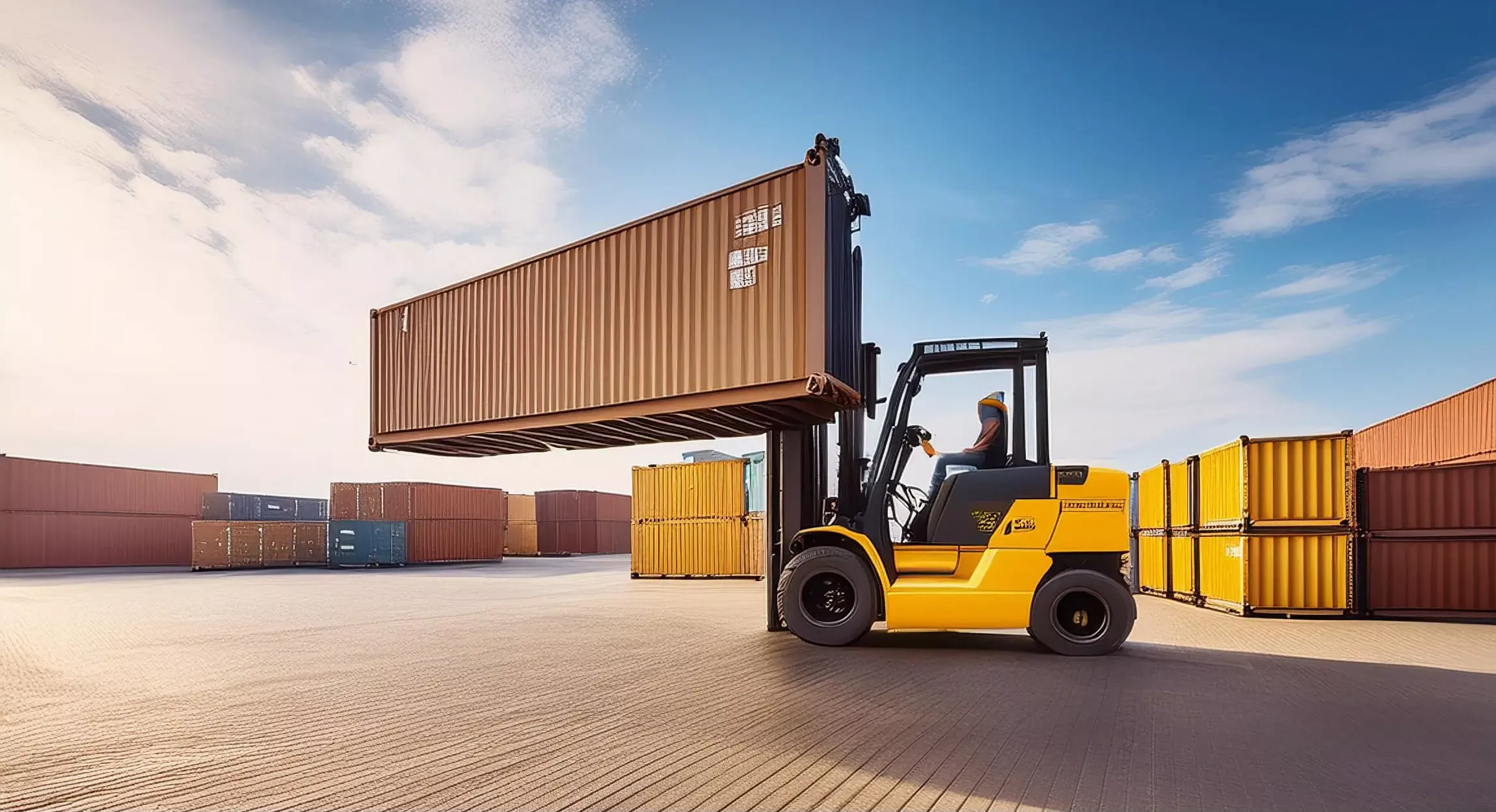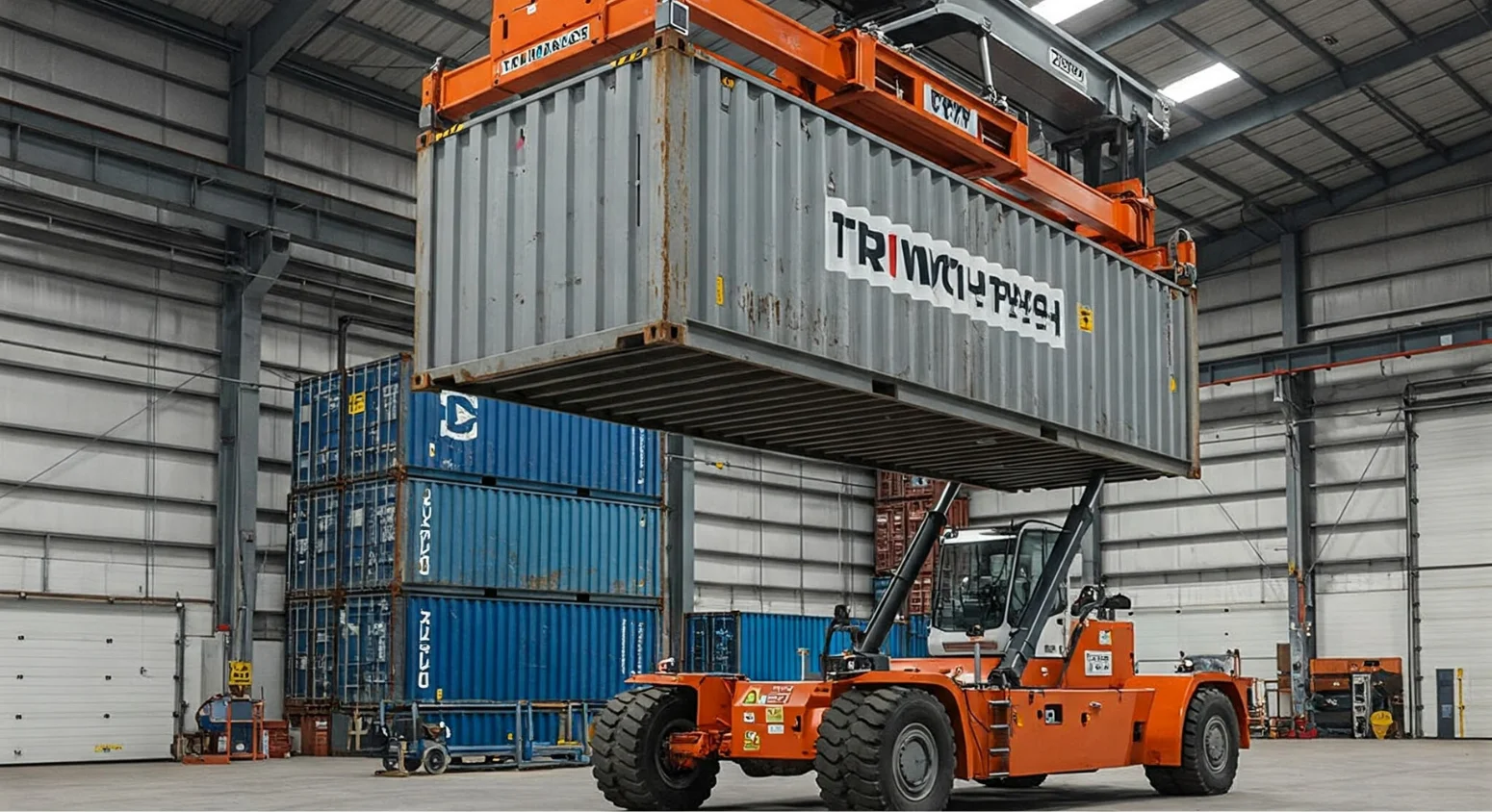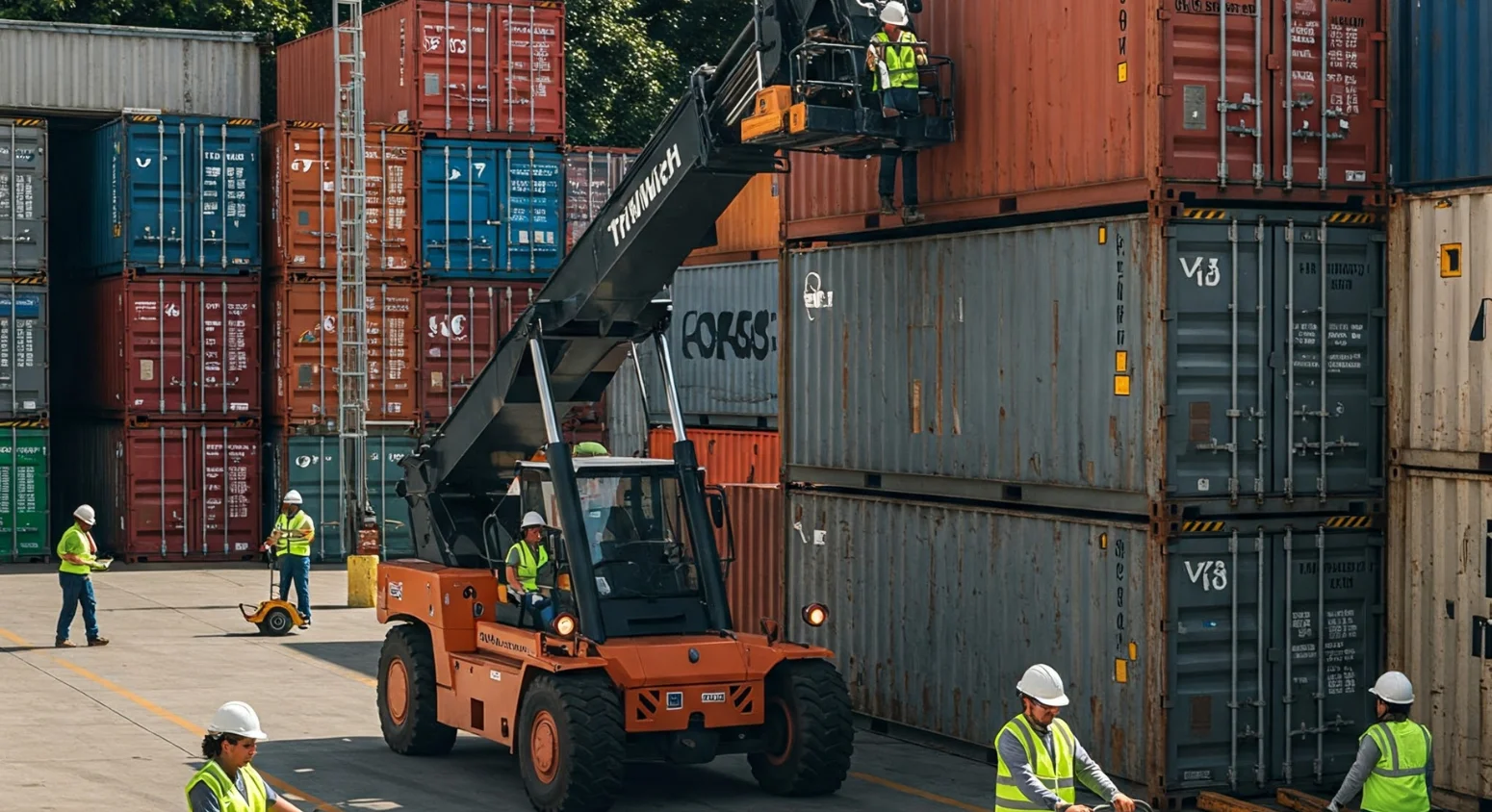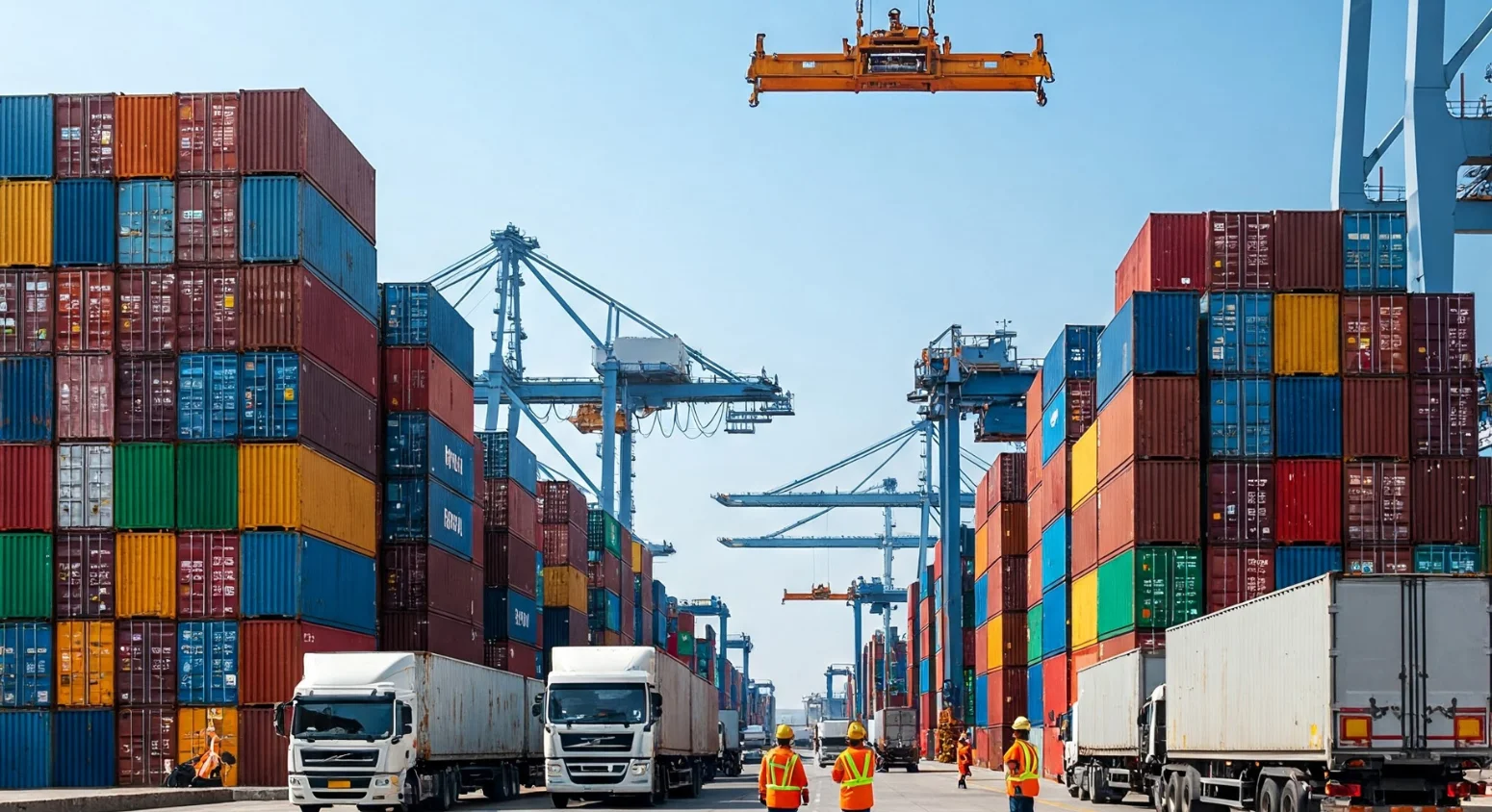Moving a shipping container with a forklift might sound simple, but if you don’t do it right, it can be risky. Containers are heavy, bulky, and not designed to be lifted like a standard pallet. So, how do you get the job done safely and efficiently?
The key is using the right tools. A standard forklift alone isn’t enough—you need proper attachments and lifting equipment, like container lifting jacks or shipping container jacks, to keep things stable. Without them, you risk tipping over, damaging the container, or even causing injuries.
In this guide, we’ll break down everything you need to know about moving a shipping container with a forklift. You’ll learn how to choose the right forklift, which attachments make lifting easier, and the step-by-step process for a smooth move. By the end, you’ll be able to handle containers with confidence—without the guesswork.
Let’s get started.
1. Understanding the Challenges of Moving Shipping Containers
Moving a shipping container isn’t as simple as lifting and setting it down. These steel giants can weigh several thousand pounds, making them difficult to handle without the right equipment. If you’re not careful, you could end up damaging the container, the forklift, or even worse—putting workers at risk. So, what makes container transportation so tricky?
Common Obstacles in Container Transportation
Before you even attempt to move a container with a forklift, it’s important to understand the challenges involved:
- Weight Distribution Issues – Shipping containers are not designed for easy lifting. Their weight isn’t always evenly distributed, which can throw off a forklift’s balance.
- Limited Forklift Compatibility – Not all forklifts are built to handle the size and weight of a container. Without the right attachments, the load can become unstable.
- Ground Conditions – Uneven terrain, soft ground, or sloped surfaces make it even harder to maneuver a container safely.
- Space Constraints – Tight spaces, like warehouses or crowded job sites, can limit a forklift’s ability to position and move a container effectively.
Safety Risks of Improper Handling
Lifting a shipping container the wrong way isn’t just inefficient—it’s dangerous. Without container jacks or specialized lifting tools, you risk:
- Forklift tip-overs – An overloaded or imbalanced forklift can easily tip forward, causing costly damage or injuries.
- Container damage – Lifting from the wrong points can bend or weaken the container’s structure, making it unsafe for future use.
- Worksite hazards – A shifting or falling container can create serious risks for workers nearby.
Why Forklifts Are a Practical Solution
Despite these challenges, it remain one of the most practical ways to move shipping containers—if you have the right setup. When paired with shipping container jacks or other lifting attachments, it can:
- Provide a controlled and stable lift, reducing the risk of tipping.
- Eliminate the need for heavy-duty cranes, saving time and money.
- Offer flexibility for moving containers in warehouses, job sites, or storage yards.
Understanding these challenges is the first step to a safe and efficient move. In the next section, we’ll break down how to choose the right forklift for the job.
2. Choosing the Right Forklift for the Job
Not all forklifts are built to handle the size and weight of a shipping container. If you try to lift one with the wrong equipment, you risk tipping over, damaging the container, or straining it beyond its limits. So, how do you know which forklift is up to the task?
Key Factors: Load Capacity, Stability, and Maneuverability
Before moving a shipping container, you need to consider a few key factors to ensure a safe and smooth lift:
- Load Capacity – A standard shipping container can weigh anywhere from 5,000 to 60,000 pounds, depending on its size and contents. Your forklift must have a high enough weight capacity to handle this load safely.
- Stability – Since containers are long and heavy, balance is crucial. A forklift with a wide wheelbase and counterweights will help prevent tipping.
- Maneuverability – If you’re working in tight spaces like a warehouse or job site, you’ll need a forklift that can navigate without difficulty. Models with rear-wheel steering or all-terrain capabilities are often the best choice.
Types of Forklifts Suitable for Moving Containers
While standard forklifts struggle with the size and weight of containers, certain types are better suited for the job:
- Heavy-Duty Forklifts – Designed for industrial lifting, it has reinforced forks, powerful hydraulics, and high load capacities, making them ideal for moving containers.
- Container Handlers – Specifically built for lifting and stacking shipping containers, these machines provide maximum control and safety.
- Rough Terrain Forklifts – If you’re working on uneven ground, a rough terrain forklift with large, durable tires and enhanced stability features will keep operations smooth.
- Modified Standard Forklifts – With the right attachments, such as container jacks or lifting extensions, even a standard forklift can be adapted for safer container transport.
Evaluating Forklift Attachments for Improved Efficiency
Even with the right forklift, lifting a container without additional equipment can be risky. That’s where specialized attachments come in:
- Container Lifting Jacks – Help raise a container off the ground so it can slide underneath safely.
- Forklift Booms – Extend lifting reach, allowing better positioning for heavy loads.
- Tire Lift Attachments – Improve balance and load distribution, reducing strain on the forklift.
By choosing the right forklift and attachments, you’ll make container lifting safer, more efficient, and less stressful. Up next, we’ll explore the essential equipment you need to streamline the process even further.
3. Essential Equipment for Safe and Efficient Lifting
Lifting a shipping container with a forklift isn’t as simple as sliding the forks underneath and lifting—it requires the right tools to ensure safety, stability, and efficiency. Without proper equipment, you risk tipping, uneven weight distribution, or even damage to the container itself. So, what should you use to make the process easier and safer?
The Role of LiftWich in Forklift Container Handling
One of the biggest challenges when lifting a shipping container is getting the forks properly positioned. That’s where LiftWich comes in. This specialized lifting system is designed to work seamlessly ensuring:
- Even weight distribution – Reduces strain on the forklift and prevents tilting.
- Secure attachment points – Prevents the container from shifting mid-lift.
- Efficient operation – Speeds up the lifting process, reducing labor time.
By using LiftWich, you turn your forklift into a powerful container-moving machine without needing costly cranes or extra manpower.
How Wheel Dollies Enhance Mobility After Lifting
Once a container is lifted, moving it into position can still be a challenge—especially in tight spaces. That’s where Wheel Dollies come in. These heavy-duty support wheels allow you to:
- Easily maneuver containers in warehouses, job sites, or storage yards.
- Reduce stress on forklifts by allowing smoother transportation.
- Improve precision placement, especially when working in confined areas.
Additional Tools to Improve Safety and Control
Along with LiftWich and Wheel Dollies, other tools can further enhance efficiency and safety:
- Container Jacks – These tools help lift containers slightly off the ground so the it can slide under them securely.
- Tire Lift Attachments – Designed to assist with load balancing, reducing strain on its tires and improving overall stability.
- Forklift Extensions – Extend the reach of your forks, making it easier to lift containers without putting excess strain on the machine.
By equipping your forklift with the right tools, you’ll not only improve efficiency but also ensure a safer, smoother lifting process. Next, we’ll break down the step-by-step method for moving a shipping container with the right way.
4. Step-by-Step Guide to Moving a Shipping Container With a Forklift
Now that you have the right forklift and lifting equipment, it’s time to put everything into action. Moving a shipping container requires more than just raw power—it takes precision, planning, and the right technique. Follow these steps to ensure a smooth and safe lift.
Step 1: Preparing the Container and Work Area
Before lifting, take a few minutes to set up your workspace. A rushed or poorly planned move can lead to costly mistakes.
- Inspect the container – Check for any structural damage that could make lifting unsafe.
- Ensure the ground is stable – Soft or uneven surfaces can cause it to lose balance.
- Clear obstacles – Make sure the path is free of debris, equipment, or people.
- Check your forklift’s weight capacity – A fully loaded container can weigh tens of thousands of pounds, so it must be able to handle the load.
Step 2: Attaching and Positioning LiftWich for Secure Lifting
A standard forklift may struggle to get the forks in the right position for lifting, which is why LiftWich is essential. Here’s how to use it effectively:
- Position the LiftWich under the container – This helps distribute weight evenly.
- Secure the attachment points – Prevents shifting during lifting.
- Check alignment – Ensure the forks are centered to avoid unbalanced weight distribution.
By using LiftWich, you reduce strain on it while improving overall stability.
Step 3: Executing a Safe and Balanced Lift
With everything in place, it’s time to lift. Follow these steps to prevent sudden shifts or instability:
- Slowly lift the container – Avoid jerky movements that could unbalance the load.
- Keep the container low – The higher you lift, the more unstable it becomes. Keep it just above ground level.
- Monitor forklift stability – If you notice tilting, lower the container immediately and readjust.
- Use gradual acceleration – Avoid sudden starts and stops to keep the load steady.
Step 4: Transporting and Positioning the Container With Precision
Once lifted, moving the container safely is the next priority. Here’s how to do it effectively:
- Use Wheel Dollies for easier maneuverability – These reduce strain on it and allow precise positioning.
- Drive at a slow, steady pace – Avoid quick turns or sudden braking.
- Ensure clear visibility – If the container blocks your view, use a spotter to guide you.
- Lower the container gently – Avoid dropping it too quickly, which could cause damage.
With these steps, you can move a shipping container confidently while minimizing risk. Next, we’ll cover essential safety best practices to keep your operation running smoothly.
5. Safety Best Practices for Forklift Container Handling
Moving a shipping container with a forklift isn’t just about power—it’s about control, precision, and above all, safety. A single mistake can lead to damaged equipment, serious injuries, or even a container tipping over. To keep your operation smooth and accident-free, follow these essential safety best practices.
Pre-Lift Safety Checks: Set Yourself Up for Success
Before you even touch the controls, take a moment to inspect everything. A quick safety check can prevent costly mistakes.
- Inspect the forklift – Check tire pressure, hydraulics, and weight capacity to ensure the machine is in top condition.
- Examine the container – Look for rusted corners, structural damage, or uneven weight distribution that could cause instability.
- Assess ground conditions – Avoid working on soft, sloped, or uneven surfaces that could lead to tipping.
- Ensure proper visibility – If the container blocks your view, use a spotter to help guide movements.
Safe Lifting Techniques: Protect Your Equipment and Crew
A forklift may be powerful, but lifting a shipping container requires careful execution. Using the right approach prevents accidents and extends the life of your equipment.
- Position the forklift correctly – Center the forks evenly under the container for maximum stability.
- Use container lifting jacks when needed – These provide extra lift clearance, making it easier to position the forks securely.
- Lift slowly and steadily – Sudden movements can throw off balance, increasing the risk of tipping.
- Keep the container low – The higher you lift, the more unstable the load becomes. Keep it just above ground level when moving.
Safe Transport and Placement: Avoid Common Pitfalls
Once the container is lifted, transporting it safely is the next challenge. Follow these guidelines to minimize risk:
- Move at a slow, controlled pace – Speeding or making sharp turns can cause instability.
- Use Wheel Dollies when needed – These reduce strain on the forklift and allow for easier positioning.
- Maintain a clear path – Ensure no workers or obstacles are in the way.
- Lower the container gently – Dropping it too quickly can damage both the forklift and the container.
Training and Awareness: The Key to Long-Term Safety
Even the best equipment won’t prevent accidents if operators aren’t trained properly. Investing in forklift safety training can help:
- Improve handling skills and hazard awareness.
- Reduce the risk of workplace injuries.
- Increase efficiency by ensuring operators use the right techniques.
By following these best practices, you’ll not only keep your team safe but also extend the lifespan of your equipment and improve overall efficiency. Now that we’ve covered safety, let’s wrap up with key takeaways and why using the right tools—like LiftWich and Wheel Dollies—makes all the difference.
Conclusion: Move Containers the Right Way
Moving a shipping container with a forklift may seem tough, but with the right tools and steps, it’s much easier. By choosing a strong forklift, using LiftWich and Wheel Dollies, and following safe lifting techniques, you can move containers without trouble.
Instead of struggling with unstable loads or risky moves, why not use the right equipment to make the job faster and safer? Whether you’re working in a warehouse, construction site, or shipping yard, proper planning and tools will save you time, effort, and possible damage.
Now that you know how to lift and move a container the right way, you’re ready to do it with confidence. Got questions? Check out these FAQs below.
FAQs
1. Can any forklift lift a shipping container?
No, only forklifts with a high weight limit can handle this job. You may also need container lifting jacks or Wheel Dollies to keep the container stable.
2. How do I stop a container from tipping over?
Make sure the forks are centered under the container, lift it slowly, and keep it close to the ground. Using tools like LiftWich helps balance the weight.
3. Should I use a forklift or a crane to move containers?
It depends. Cranes are best for stacking containers, but forklifts are cheaper and more flexible for ground transport, especially when using Wheel Dollies or container movers.
4. What’s the safest way to move a container after lifting it?
Move slowly, avoid sudden turns, and make sure you can see clearly or have a helper guide you. Using Tire Lift attachments or Wheel Dollies makes it easier.



